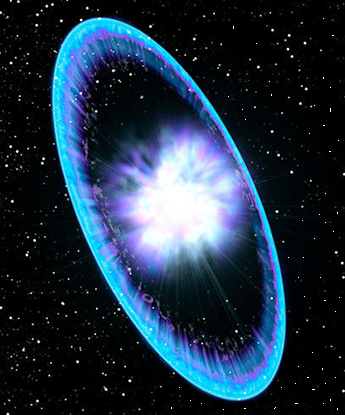Supernovas can occur in two different and distinct ways. One of the ways in which a supernova can be triggered is through the instantaneous ignition of a nuclear fusion reaction in a degenerate star (star at end of its life).
For example, a white dwarf, in a binary system, may accumulate material from that companion star that eventually raises its core temperature. This increase in core temperature is enough to ignite carbon fusion, which ultimately causes a runaway nuclear fusion reaction.
The amazing part of this entire process is that the core temperature of the degenerate star must reach at least 5×108 K. The luminosity that is observed by these supernovae is due to the immense energy that is emitted due to the nuclear fusion reaction. The energy exchange that occurs during this emission process can be explained by Einstein’s famous equation E=mc2 .
The second way that a supernova can occur is through the collapse of the core of a massive star. One thing that is important to remember that a star prevents collapse by balancing the force of gravity acting upon that star with the pressure created due to the exchange of matter and energy.
When the core of a massive star collapses under its gravity, gravitational collapse, gravitational potential energy is released. This potential energy that is released is what is responsible for the creation of a supernova explosion. It is evident from both mechanisms of supernova formation that the amounts of energy involved are astronomical.
There are two types of supernovae and they are classified on the basis of their light curves and absorption lines. A light curve is a graph that depicts the light intensity of an object as a function of time. The first element utilized to classify supernovae is hydrogen. The classification is based on the presence or absence of a line due to hydrogen.
If the supernova contains a spectral line corresponding to hydrogen, it is a Type II supernova, while those lacking a hydrogen spectral line are classified as Type I. Type I and Type II supernovae are further divided based on the presence of spectral lines corresponding to other elements such as Helium and Silicon.
It is useful to know that Type 1a, contains a strong silicon spectral line, supernovae are used as standard candles. The next aspect of supernovae I will discuss is the interstellar impact.
One important consequence of supernovae is that they serve as a source of heavy elements (elements heavier than Oxygen). These heavy elements are formed due to the nuclear fusion that occurs in the core of these stars. An important mechanism in supernovae is nucleosynthesis.
This process creates new atomic nuclei from pre-existing nucleons (protons/neutrons). Nucleosynthesis helps to create elements that are heavier than Iron-56, while nuclear fusion creates Iron-56 and lighter elements). Perhaps the extensive study of supernovae will help produce insight into the universe at its inception (Big Bang).
The remnant of a supernova explosion accumulates surrounding the interstellar medium during an expansion phase, which can last up to 200 years. This accumulation wave then undergoes an interval of adiabatic expansion and slowly mixes with the surrounding medium over approximately 10,000 years.
It is understood that The Big Bang produced hydrogen, helium, and small amounts of lithium. However, supernovae have enriched the surrounding medium with heavier elements as well as metals. Therefore, the composition of each stellar generation changes due to the creation of varying levels of metals and heavy elements by these stellar bodies (i.e. overtime, the interstellar medium has gone from a hydrogen-helium-rich mixture to a metal-rich composition).
Another important result of supernovae explosion is that the energy released can trigger nearby star formation due to the compression of dense molecular clouds in the surrounding interstellar medium. It is this production of heavy elements over time that has helped foster the chemistry necessary for life on Earth.

